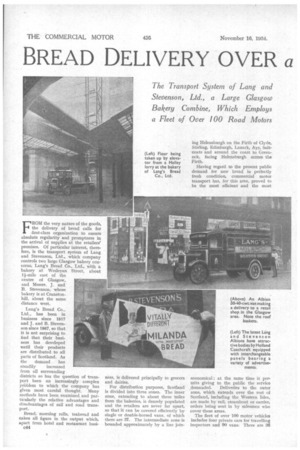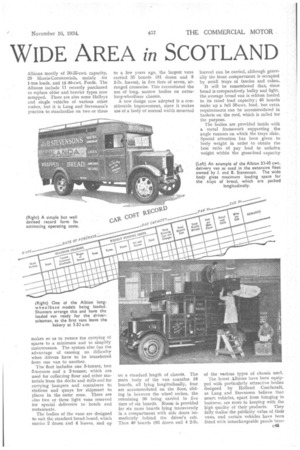BREAD DELIVERY OVER a
Page 110

Page 111

Page 112

If you've noticed an error in this article please click here to report it so we can fix it.
The Transport System of Lang and Stevenson, Ltd., a Large Glasgow Bakery Combine, Which Employs a Fleet of Over 100 Road Motors
FROM the very nature of the goods, the delivery of bread calls for first-class organization to ensure absolute regularity and promptness in the arrival of supplies it the retailers' premises. Of particular interest, therefore, is the transport system of Lang and Stevenson, Ltd., which company controls two large Glasgow bakery concerns, Lang's Bread Co., Ltd., with a bakery at Wesleyan Street, about 1 i-mile east of the centre of Glasgow, and Messrs. J. and B. Stevenson, whose bakery is at Cranston.. bill, about the same distance west.
Lang's Bread Co., Ltd., has been in business since 1817 and J. and B. Stevenson since 1867, so that it is not surprising to find that their business has developed until their products are distributed to all parts of Scotland. As the demand has steadily increased from all surrounding districts so has the question of transport been an increasingly complex problem to which the company has given most careful thought. Many methods have been examined and particularly the relative advantages and disadvantages of rail and road transport.
Bread, morning rolls, teabrea.d and cakes all figure in the output which, apart from hotel and restaurant busi c44 ness, is delivered principally to grocers and dairies.
For distribution purposes, Scotland is divided into three zones. The inner zone, extending to about three Miles from the bakeries, is densely populated and the retailers are never far apart, so that it can be covered efficiently by single or double-horsed vans, of which there are 37. The intermediate zone is bounded approximately by a line join
economical ; at the same time it permits giving to the public the service demanded. Deliveries to the outer zone, which extends over the rest of Scotland, including the Western Isles, are made by rail, steamboat or carrier, orders being sent in by salesmen who cover these areas.
The fleet of over 100 motor vehicles includes four private cars for travelling inspectors and 90 vans. There are 36
makes so as to reauce the carrying of spares to a minimum and to simplify maintenance. The system also has the advantage of causing no difficulty when drivers have to be transferred from one van to another.
The fleet includes one 5-tonner, two 3-tonners and a 2-tonner, which are used for collecting flour and other materials from the docks and mills and for carrying hampers and containers to, stations and quays for shipment to places in the outer zone. There are also two or three light vans reserved for special deliveries to hotels and restaurants.
The bodies of the vans are designed to suit the standard bread board, which carries 2 dozen and 4 loaves, and up
on a standard length of chassis. The main body of the van contains 34 boards, all lying longitudinally, four are accommodated on the floor, sliding in between the wheel arches, the remaining 30 being carried in five tiers of six boards. Room is provided for six more boards lying transversely in a compartment with side doors immediately behind the driver's cab. Thus 40 boards (93 dozen and 4 2-1b. of the various types of chassis used.
The latest ilabions have been equipped with particularly attractive bodies designed by Holland Coachcraft, as Lang and Stevenson believe that smart vehicles, apart from bringing in business, are more in keeping with the high quality of their products. They fully realize the publicity value of their vans, and certain vehicles have been fitted with interchangeable panels bear
big advertisements covering the whole area of the sides of the van.
The vans carrying bread from Lang's Bread Co., Ltd., are painted dark green with a silver panel, while those bearing the name of J. and B. Stevenson are finished in vermilion with gold lettering, the original van colours being retained when the interests of the two were combined, since the colour schemes were practically synonymous with their respective names.
The vehicles are kept at the garage in Wesleyan Street. This building has a floor area of 22,400 sq. ft, and is free of pillars, having what is probably the largest single-span garage roof in Glasgow. Two petrol pumps, conveniently placed for vans entering or leaving, draw supplies from 5,000-gallon tanks. The procedure is for the vehicles to be refuelled on return from the day's journey.
During the night the vans are washed and thoroughly cleaned. When the
first batches of bread are due the vehicles for the outlying districts are driven by shunters to the bread store and barked into the bays. The wrapped loaves arrive by conveyor, and according to salesmen's individual requirements, the bread boards are quickly filled by hand and slid into the vans. The shunters then line the vans up, either in the bread store or back in the garage, so that when the drivers arrive they have only to check their loads. The vans for the farthest areas leave from 5.30 a.m. onwards, all are away by 7 a.m. Between 4 a.m. and 6 a.m. the Morris 1-ton vans are busy with morning-roll deliveries to dairies.
Dividing Into Delivery Zones.
The zone served by the vans is divided into blocks, to each of which one Albion or Ford 30-cwt. van is allocated. Each is operated by a driver-salesman accompanied by a van boy. The driver works around his area selling to retailers as he goes, and delivers on the spot. Where sales exceed a full van load. Morris-Commercial vans are used as feeders, Sometimes the load is transferred at a pre-determined point, sometimes a junior driversalesman works a portion of the area under the control of the senior man.
This is considered a more economical
c46 and efficient method of working than the establishment of outlying depots where loads received in bulk from the bakeries would be transferred to vans for delivery to the retailers. On Saturdays the sales are approximately 75 per cent, higher than through the week and " meeting " vans are sent out to ensure that no salesman will be short of supplies for his customers.
Details of Journeys.
Each driver uses the same van daily. The mileage varies considerably. The vans working the nearer districts cover only about 25 miles a day whilst those operating farther afield run up to 80 miles a day. The Edinburgh van has the longest journey, and covers about 640 miles weekly. The average number of calls per van per round is 70.
The vanmen are selected primarily as salesmen, but have to become competent drivers, and must satisfy the garage manager before taking charge of a van, Each man has a weekly log book for the records required by law, and the book is handed in on Saturdays. The entries are checked and the records filed.
They are, of course, supplementary to the records of petrol, oil, etc. The driver is also responsible for handing in each day a form drawing attention to any fault he has noticed or notifying the vehicle as correct. This enables the maintenance work to be properly organized.
At the garage at Wesleyan Street, there is an efficient staff of mechanics, coachbuilders and painters, and two machines are brought in for complete overhaul each week. The unit-replacement system is employed to an extent for the lighter vans, but generally vehicles are given a straight overhaul and rebuilt with the original units.
Running adjustments are carried out at night (the afternoon for vans operating on short runs). Brakes are inspected weekly. Two electricians work
ing day and night shifts deal with battery maintenance and electrical faults notified on the report sheets.
Other checks are provided by the garage manager, who makes inspections at intervals, and by the night shunters who are skilled men trained to notice incipient trouble. Greasing and running adjustments are carried out at night under the control of the night foreman, who is a fully qualified mechanic, and whose inspection is an additional means for detecting faults.
Tyres are not run on mileage-contract terms, but purchases are confined to well-known makes, and inspectors from the tyre companies pay monthly visits of inspection to check their condition. Three men are employed on tyre maintenance, checking pressure, alignment, etc., so that with a tyre not giving normal mileage, little difficulty is experienced in obtaining a fair adjustment from the maker.
Individual cost records are kept fol.
each vehicle, a form being used to keep a note of all charges, both overhead and running. Maintenance items appearing on this form are set out in detail on a separate "Maintenance Record Card." The running total of motor vehicle costs are reconciled with the financial controls kept in the Accountant's Department.
Each machine is allocated a log book in which appears a note of the date, and extent of all overhauls, dates of valve grinding and all adjustments, etc. A special book is kept dealing entirely with brake adjustments and covering the whole fleet. Wall charts in the garage office permit instant reference to dates of overhauls, painting and valve grinding.
Journey Recorders Prove . Unsuitable.
Automatic recorders have been tried out, but were not found suitable for the work, as the salesman in charge of a van must, to a great extent, be allowed to exercise his own judgment as to the time to be spent with individual customers.
An indication of the efficiency of the transport organization, which is under the in-Inn-di-ate control of a di-ector, is the fact that only two people are employed in the garage office,




















































































































































































